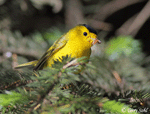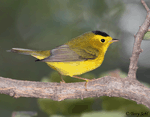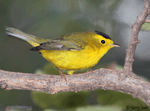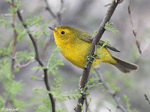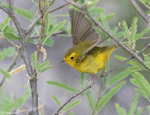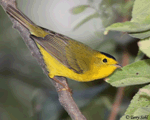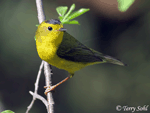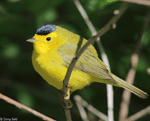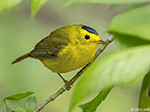| Length: 4.75 inches | Wingspan: 7.5 inches | Seasonality: Migrant |
| ID Keys: Yellow underparts, olive-green upperparts, bright yellow face with black cap (male) | ||
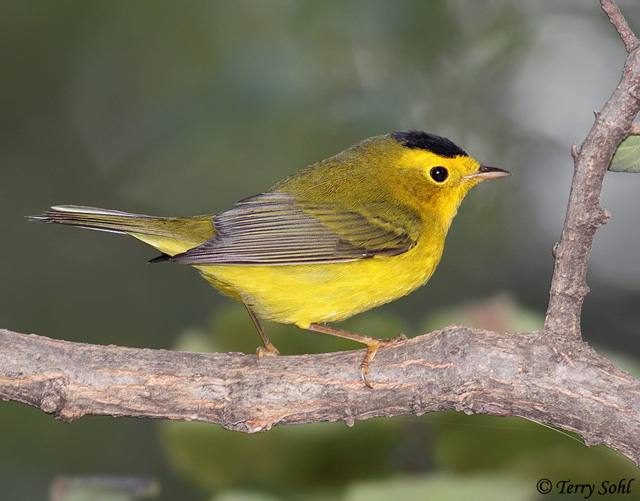 A small, very active warbler of thickets and woodland edges,
Wilson's Warblers are often more readily identified by birders due to their
habit of foraging quite low in forest vegetation. They can be found nearly
anywhere in the continental United States during their spring migration, but are
generally much more common in the West than in the East. They tend to
have increasingly brilliant plumage the as you move westward in the continent.
A small, very active warbler of thickets and woodland edges,
Wilson's Warblers are often more readily identified by birders due to their
habit of foraging quite low in forest vegetation. They can be found nearly
anywhere in the continental United States during their spring migration, but are
generally much more common in the West than in the East. They tend to
have increasingly brilliant plumage the as you move westward in the continent.
Habitat:
Prefers low, shrubby undergrowth, such as that along streams, rivers and ponds, second-growth forest, and forest understory. Avoids dense unbroken forest, and is normally found along forest and woodland edges.
Diet:
Primarily insects and spiders, but occasionally berries.
Behavior:
Usually forages quite low in vegetation. Will also forage along the ground, or fly out from a low perch to catch insects in mid-air.
Breeding:
Non-breeder in South Dakota. In breeding range, the nest is a cup of grasses, leaves, and moss, built by the female. The female lays betweedn 4 and 6 eggs, and she alone incubates the eggs. Upon hatching, both parents help feed the young, with the young leaving the nest after about 10-13 days.
Song:
Rapid series of 10 to 15 short whistled notes, with the last few notes generally lower and faster. They also have a chip note call.
- Click here to hear the song of a Wilson's Warbler1
- Click here to hear the call note of a Wilson's Warbler2
Migration:
Summers in Canada and the western United States. Winters on the Gulf Coast, Mexico, and points south.
Interactive eBird map:
Click here to access an interactive eBird map of Wilson's Warbler sightings
Similar Species:
The distinctive black cap on a male Wilson's Warbler make it relatively distinctive if seen well. The more uniformly colored female may be more difficult to identify. Here are some other warbler species that may be confused with a Wilson's Warbler.
- Hooded Warbler - Both species share a similar olivish-colored back and yellow underside, with a black cap (males). However, male Hooded Warblers have black throat that connects with the cap behind the face, while Wilson's Warblers simply have the small black cap. Female Hooded Warblers are similar to female Wilson's Warblers. However, female Hooded Warblers have more contrast between an olive-colored cap and nap and a yellow face, as opposed to the more evenly yellow colored female Wilson's Warbler.
- Yellow Warbler - Yellow Warblers won't be confused with a male Wilson's Warbler, given the black cap on the Wilson's. However, they could easily be confused with the mostly yellow female Wilson's Warbler. Note that Yellow Warblers have some obvious yellow edging on the wings that is generally lacking on Wilson's Warblers.
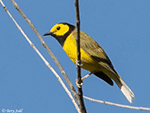 |
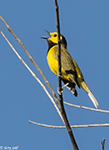 |
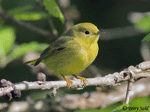 |
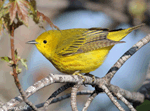 |
| Hooded Warbler | Hooded Warbler | Yellow Warbler | Yellow Warbler |
Conservation Status:
Stable in some locations, but has been on the decline in the west, probably due to loss of riparian habitat. However, there are no serious threats to overall populations, and the IUCN lists the Wilson's Warbler as a species of "Least Concern".
Further Information:
Photo Information:
September 2nd, 2012 - Minnehaha County, South Dakota - Terry Sohl
Additional Photos:
Click on the image chips or text links below for additional, higher-resolution Wilson's Warbler photos.
Audio File Credits:
- 1Thomas G. Graves. Recorded in Montana de Oro State Park in California on May 21st, 2020. Original recording and information from xeno-canto.
- 2Ed Pandolfino. Recorded in Sonoma County, California on July 29th, 2016. Original recording and information from xeno-canto.
| Click on the map below for a higher-resolution view |
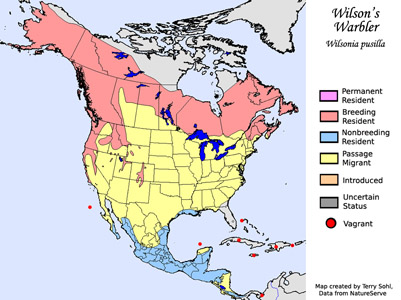 |
| South Dakota Status: Uncommon migrant throughout the state, except common in fall in the East. |
Additional Wilson's Warbler Photos
Click for a higher-resolution version of these photos
